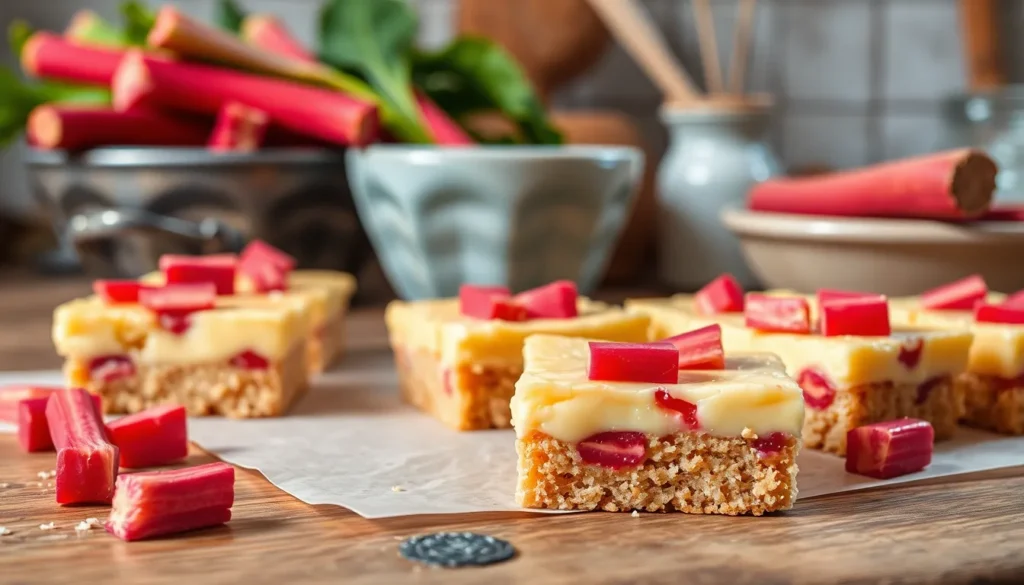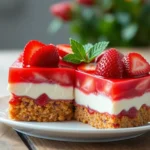When spring arrives and rhubarb stalks emerge from the garden, we can’t help but get excited about all the delicious possibilities ahead. These rhubarb custard bars perfectly capture that sweet-tart balance we crave, combining tender rhubarb with a silky smooth custard layer that’ll have your taste buds singing.
We’ve discovered that the secret to exceptional rhubarb custard bars lies in the contrast of textures. The buttery shortbread crust provides the perfect foundation, while the creamy custard filling creates a luxurious backdrop for the tangy rhubarb pieces. Each bite delivers that satisfying combination of rich and refreshing flavors that makes these bars absolutely irresistible.
Whether you’re looking to use up an abundance of garden rhubarb or simply want to treat your family to something special, these bars are guaranteed crowd-pleasers. They’re elegant enough for entertaining yet simple enough for everyday enjoyment, making them our go-to dessert when we want to impress without the stress.
Ingredients
Our rhubarb custard bars require three distinct components that work together to create the perfect balance of textures and flavors. Each layer serves a exact purpose in building this delightful dessert.
For the Crust
- 1 cup all-purpose flour
- 1/2 cup unsalted butter, cold and cubed
- 1/4 cup granulated sugar
- 1/4 teaspoon salt
- 1 large egg yolk
- 1-2 tablespoons ice water (as needed)
For the Custard Filling
- 3 large eggs
- 1 cup granulated sugar
- 1/4 cup all-purpose flour
- 1/2 teaspoon vanilla extract
- 1/4 teaspoon salt
- 1 cup heavy cream
- 1/4 cup whole milk
For the Rhubarb Layer
- 3 cups fresh rhubarb, cut into 1/2-inch pieces
- 1/3 cup granulated sugar
- 2 tablespoons cornstarch
- 1 tablespoon fresh lemon juice
- 1/4 teaspoon ground cinnamon
Equipment Needed
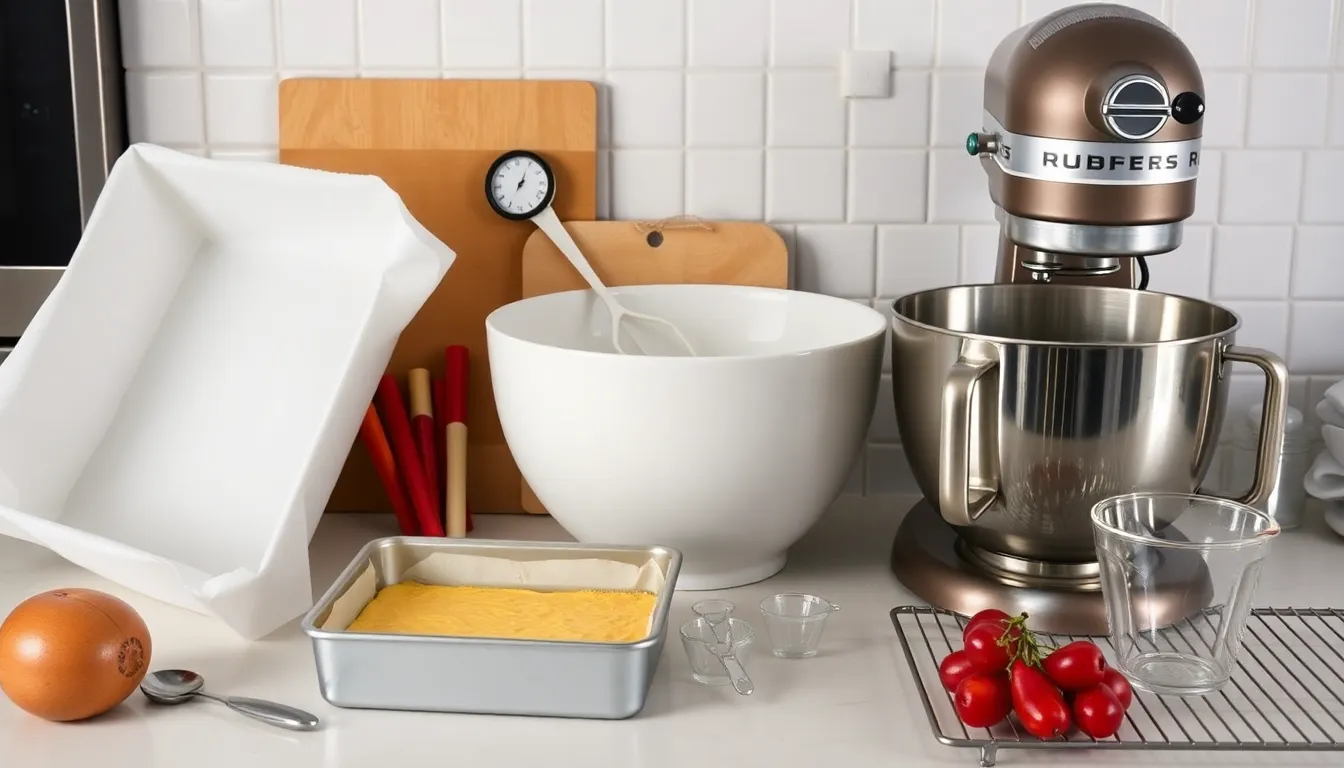
Creating perfect rhubarb custard bars requires exact tools to ensure success throughout the baking process. We recommend gathering all equipment before starting to streamline your workflow and achieve professional results.
Essential Baking Equipment:
- 8 or 9-inch square baking dish (or 13×9-inch for larger recipes)
- Oven thermometer for accurate temperature control
- Parchment paper for easy removal
- Wire rack for proper cooling
Mixing and Measuring Tools:
- Large mixing bowl for combining ingredients
- Hand or stand mixer for smooth custard preparation
- Measuring cups and spoons or digital kitchen scale for precision
- Rubber spatula or wooden spoon for folding ingredients
We prioritize using an oven thermometer because accurate temperature control prevents overcooking the delicate custard layer. The digital kitchen scale offers superior accuracy compared to measuring cups when working with flour and butter ratios.
Square baking dishes work best for these bars as they provide even heat distribution and create uniform portions. Parchment paper becomes essential for lifting the finished bars cleanly from the pan without damaging the tender crust.
Our preferred mixing method involves using a stand mixer for the custard filling to achieve the smoothest consistency. But, a hand mixer works equally well for smaller batches and provides more control over mixing speed.
Wire racks allow proper air circulation during cooling, preventing soggy bottoms that can occur when bars cool directly in the pan. This equipment setup ensures each layer maintains its intended texture from the crispy crust to the silky custard filling.
Instructions
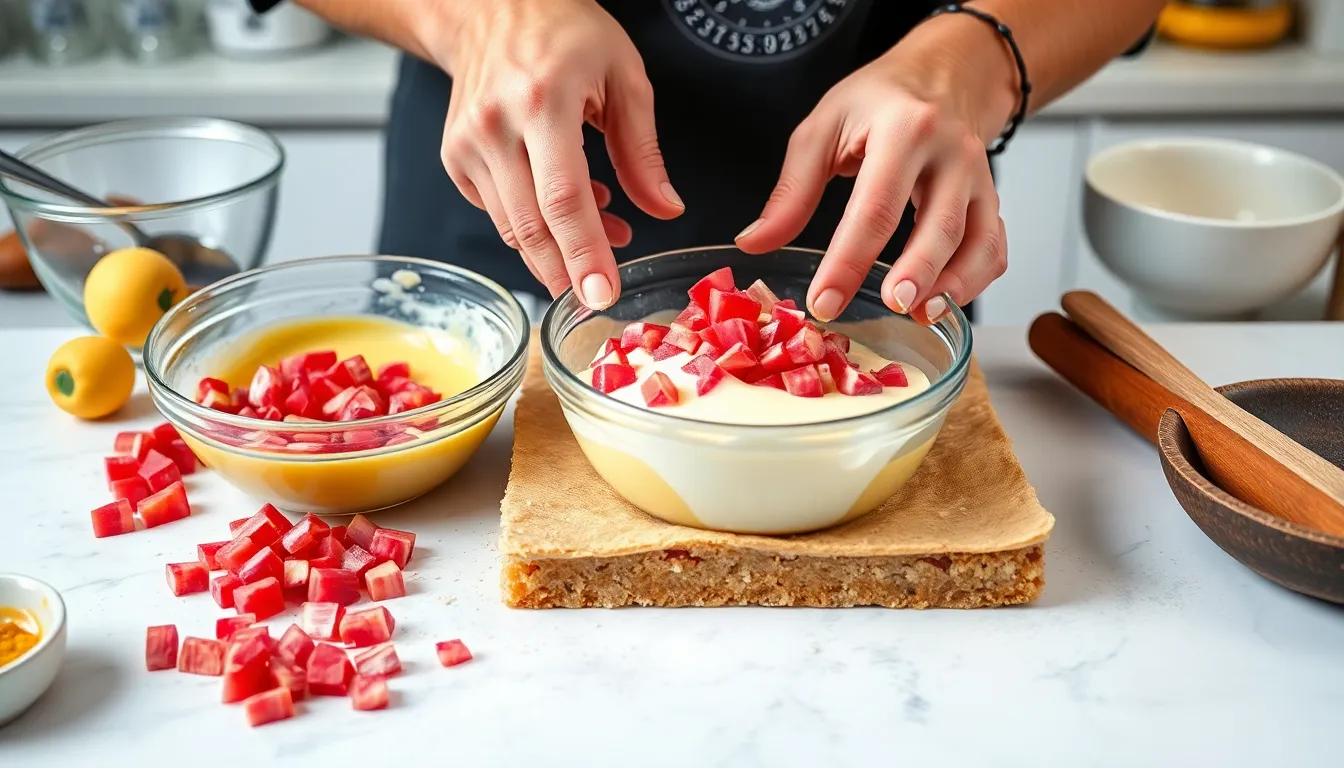
Now we jump into the step-by-step process that transforms simple ingredients into these irresistible rhubarb custard bars. Each stage builds upon the last to create the perfect balance of textures and flavors.
Prep the Rhubarb
We start by discarding the rhubarb leaves completely as they contain toxic compounds. Slice the stalks into uniform pieces measuring 1/4 to 1/2 inch thick for even distribution throughout our custard layer. Late-season rhubarb often develops tough skin that we can peel away if necessary for optimal texture. Measure out 4 to 5 cups of chopped fresh rhubarb or use thawed and well-drained frozen rhubarb as an alternative.
Make the Crust
We combine our all-purpose flour and sugar in a large mixing bowl before adding cold butter pieces. Cut the butter into the dry ingredients using a pastry blender or fork until the mixture resembles coarse crumbs with some pea-sized pieces remaining. Our food processor works perfectly for this task if we prefer a more uniform texture. Press this mixture firmly and evenly into our greased or parchment-lined 9×13-inch baking pan. We pre-bake the crust at 350°F for 10 to 15 minutes until it just begins to set but hasn’t browned completely.
Prepare the Custard Filling
We whisk together eggs and sugar in a separate bowl until the mixture becomes light and well combined. Add flour and salt to this base while continuing to whisk until completely smooth without any lumps. Pour in cream or half-and-half gradually while whisking to create our silky custard base. Gently fold the prepared rhubarb pieces into this custard mixture ensuring even distribution throughout.
Assemble the Bars
We remove our pre-baked crust from the oven and immediately pour the rhubarb custard filling over the warm surface. Spread the mixture evenly using a spatula to ensure uniform thickness across the entire pan. The rhubarb pieces should be distributed evenly without any concentrated areas that might affect baking consistency.
Bake the Bars
We return the assembled bars to our 350°F oven and bake for 30 to 45 minutes. The center should appear nearly set with just a slight jiggle when we gently shake the pan while the edges turn golden brown. Our custard layer will continue setting as it cools so we avoid overbaking which can result in a rubbery texture.
| Baking Stage | Temperature | Time Range | Visual Cues |
|---|---|---|---|
| Pre-bake Crust | 350°F | 10-15 minutes | Just set, not browned |
| Final Bake | 350°F | 30-45 minutes | Nearly set center, golden edges |
Cooling and Cutting

Patience becomes essential once we remove our rhubarb custard bars from the oven. We must allow the bars to cool completely before attempting to cut them. This crucial step ensures the custard sets properly and maintains its silky texture while preventing the bars from falling apart.
The cooling process requires letting the bars sit undisturbed until they reach room temperature. We recommend placing the baking dish on a wire rack to promote even cooling. During this time the custard continues to firm up and develop its perfect consistency.
When we use frozen rhubarb instead of fresh, we should expect a longer cooling period due to the extra moisture content released during baking. This additional moisture needs time to evaporate and allow the custard to achieve its ideal texture.
| Cooling Factor | Time Required | Key Points |
|---|---|---|
| Room temperature cooling | 2-3 hours minimum | Essential for proper custard setting |
| Frozen rhubarb version | 3-4 hours | Extra moisture requires longer cooling |
| Refrigerator chilling | Additional 1-2 hours | Optional but recommended for easier cutting |
Once our bars have cooled completely at room temperature, we can begin the cutting process. We start by running a knife around the edges to loosen the bars from the pan. The first square often proves challenging to remove cleanly, but subsequent cuts become significantly easier.
For optimal results we recommend chilling the cooled bars in the refrigerator for an additional hour or two before cutting. This extra step makes the bars more cohesive and creates cleaner cuts with well-defined edges.
We cut the bars into uniform squares using a sharp knife, wiping the blade clean between cuts. The custard should hold its shape beautifully while the crust maintains its tender yet sturdy structure. Light golden spots on the custard surface are completely normal and indicate proper baking without affecting the overall quality or taste of our finished bars.
Storage Instructions
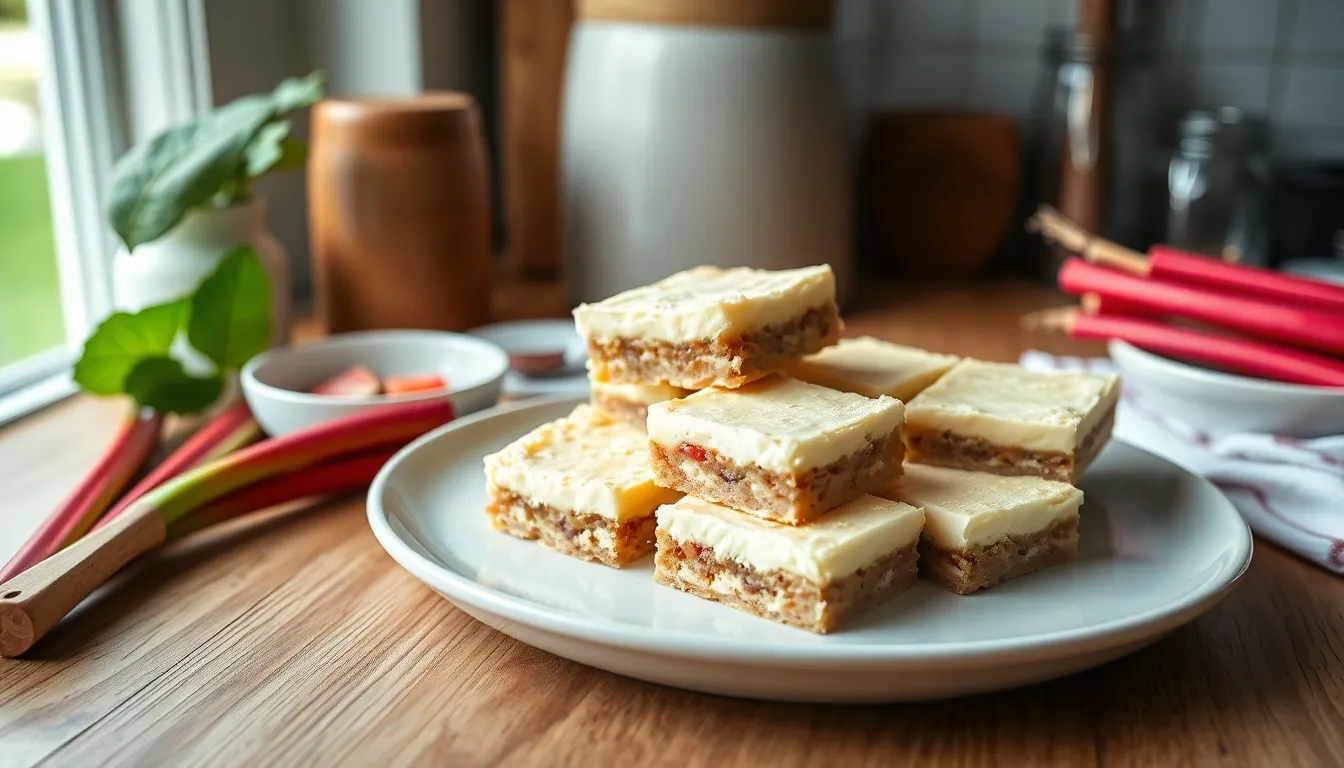
We recommend storing your rhubarb custard bars properly to maintain their creamy texture and fresh flavor. The custard filling requires careful handling to preserve its silky consistency throughout the storage period.
Refrigerator Storage
Our rhubarb custard bars stay fresh in the refrigerator for up to four days when stored correctly. We suggest placing the bars in an airtight container to prevent them from absorbing other flavors and to maintain moisture levels. Plastic wrap provides an alternative covering method that works equally well for short-term storage.
| Storage Method | Duration | Container Type |
|---|---|---|
| Refrigerated | Up to 4 days | Airtight container or plastic wrap |
| Frozen | Up to 2-3 months | Freezer-safe container or bag |
Freezer Storage Options
Freezing these bars presents mixed results due to potential texture changes in the custard layer. We can freeze them for up to three months by arranging them in a single layer within an airtight container. But, some bakers experience texture modifications after thawing that may affect the overall quality.
For those who choose to freeze the bars, we recommend wrapping each piece individually before placing them in a freezer-safe container or bag. This method works best for storage periods up to two months. Thawing overnight in the refrigerator ensures gradual temperature change and helps preserve texture.
Serving Temperature Tips
We find that bringing the bars to room temperature before serving enhances their flavor profile significantly. The custard layer becomes more pronounced and the overall taste improves when the bars warm slightly from refrigerator temperature. This process typically takes 15-20 minutes at room temperature for optimal results.
Tips for Perfect Rhubarb Custard Bars
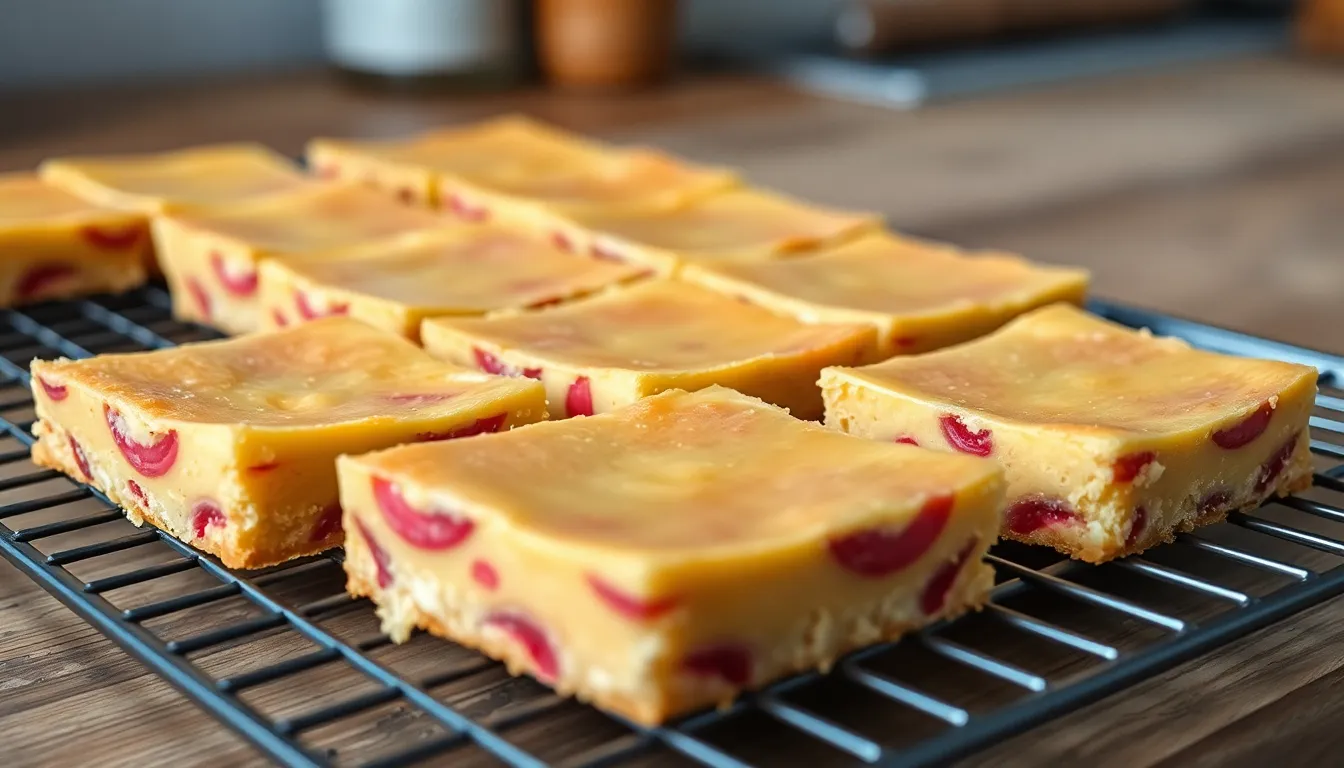
Mastering these rhubarb custard bars requires attention to detail and our proven techniques. We recommend selecting fresh rhubarb stalks for the best flavor and texture throughout your bars.
Choose Quality Rhubarb
Fresh rhubarb delivers superior taste compared to frozen alternatives. We suggest picking stalks that feel firm and display vibrant color without any soft spots. Cut your rhubarb into uniform pieces measuring approximately ½ inch to ensure even cooking and distribution.
Monitor Your Baking Temperature
Temperature control prevents overcooking and maintains the ideal custard consistency. We always preheat our oven to exactly 350°F and use an oven thermometer to verify accuracy. Baking the crust for 10-15 minutes creates the perfect foundation without browning too deeply.
Achieve the Perfect Custard Set
Timing determines whether your custard layer achieves silky smoothness or becomes overcooked. We bake the assembled bars for 40-45 minutes until the center appears nearly set but still slightly jiggly. The edges should develop a light golden color while the center remains pale.
Cool Completely Before Cutting
Patience during cooling prevents messy cuts and maintains clean bar shapes. We refrigerate our bars for at least one hour after they reach room temperature to ensure proper setting. This cooling process allows the custard to firm up completely.
Test for Doneness Properly
Visual cues guide us better than strict timing when determining if bars are ready. We look for custard that no longer appears wet on the surface and edges that pull slightly away from the pan sides. A gentle shake of the pan should show minimal movement in the center.
Variations and Substitutions
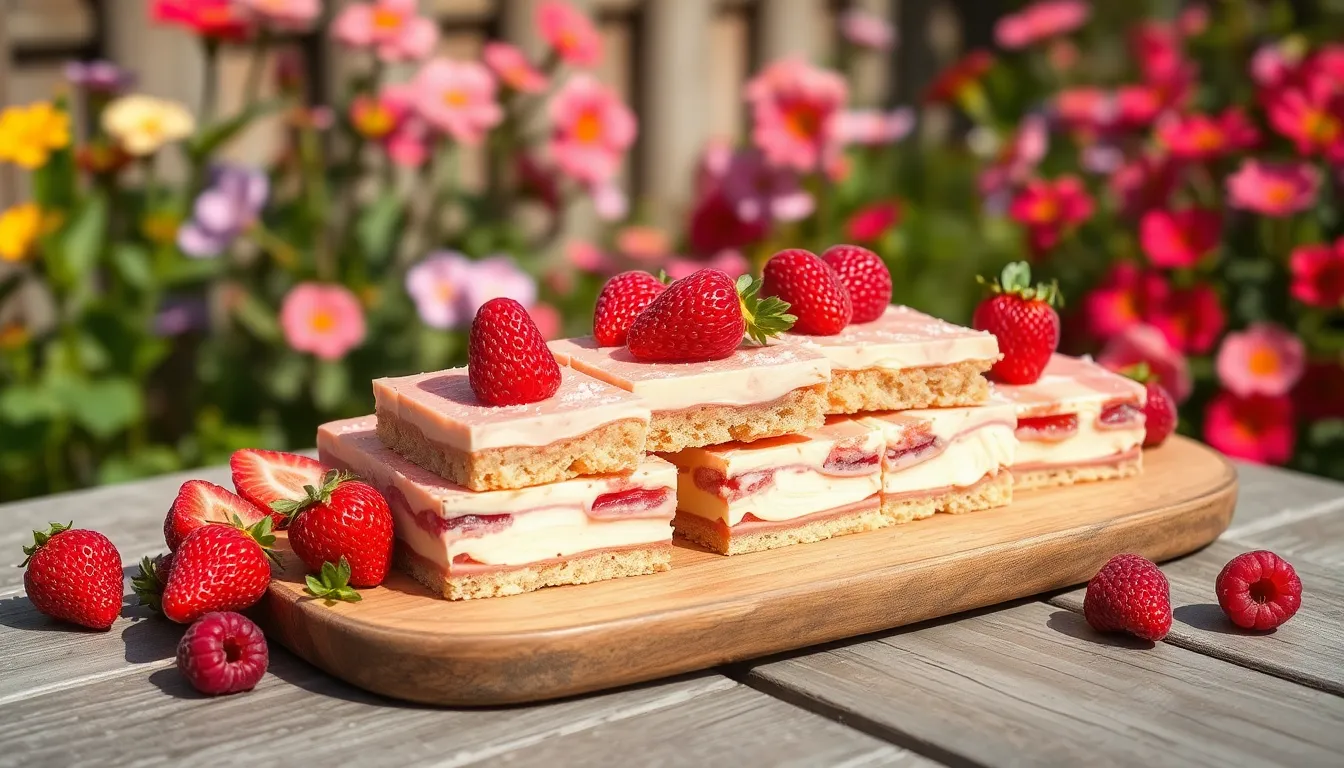
We love how adaptable this rhubarb custard bars recipe can be to suit different tastes and dietary needs. These creative modifications allow us to enjoy this dessert in countless ways while maintaining the perfect balance of textures and flavors.
Fruit Combinations
Rhubarb pairs beautifully with other spring and summer fruits. We recommend adding strawberries to create a classic combination that reduces the tartness while adding natural sweetness. Fresh raspberries also work wonderfully and contribute their own unique tang that complements the rhubarb perfectly. When using fruit combinations, we maintain the same total fruit measurement but split it between rhubarb and our chosen companion fruit.
Crust Alternatives
We can transform the base of our bars by experimenting with different crust options. A graham cracker crust offers a completely different texture and adds a subtle honey flavor that pairs well with the tangy rhubarb. Simply crush graham crackers and mix with melted butter instead of creating the traditional shortbread base. This substitution works particularly well when we want to save time or create a more casual dessert presentation.
Creative Toppings
Beyond the classic presentation, we can elevate our rhubarb custard bars with various toppings. Whipped cream provides a light and airy contrast to the dense custard filling. A caramel drizzle adds richness and creates an elegant finish for special occasions. Cream cheese frosting remains our top choice for those who prefer a tangy complement to the sweet custard layer.
Ingredient Substitutions
For the crust preparation, we can use melted butter instead of cold butter to simplify the mixing process. This approach creates a slightly different texture but maintains the buttery flavor we love. Oat flour substitutes beautifully for all-purpose flour and adds a subtle nutty undertone that enhances the overall flavor profile.
When modifying the custard filling, heavy whipping cream replaces regular cream for an even richer texture. We find this substitution particularly beneficial when serving the bars for special occasions. For those following vegan diets, flax eggs work as an effective egg replacement, though the texture will be slightly different from the traditional version.
Dairy-Free Options
We can accommodate dairy-free preferences by using vegan cream cheese or mascarpone for the topping. These alternatives maintain the creamy texture while providing the tangy flavor that balances the sweet custard filling. Plant-based milk substitutes work well in the custard, though we recommend using full-fat versions for the best texture.
Implementation Guidelines
When making substitutions, we follow the same basic technique with slight modifications. For crust variations, we mix our chosen ingredients and press them into the prepared pan before baking at 350°F for 10-12 minutes. The filling process remains consistent regardless of substitutions: we combine our ingredients, fold in the rhubarb, and pour over the pre-baked crust before baking at 325°F for 30-40 minutes. These timing guidelines ensure our bars achieve the perfect set regardless of the variations we choose.
Conclusion
These rhubarb custard bars have truly earned their place as one of our favorite spring desserts. The combination of buttery crust tangy rhubarb and silky custard creates a dessert that’s both elegant and comforting.
We’ve found that taking the time to follow each step carefully makes all the difference in achieving that perfect texture balance. From properly cooling the bars to selecting the freshest rhubarb your attention to detail will shine through in every bite.
Whether you’re hosting a dinner party or simply treating your family to something special these bars deliver impressive results without overwhelming complexity. They’re proof that some of the best desserts come from simple quality ingredients prepared with care.
Frequently Asked Questions
What are rhubarb custard bars?
Rhubarb custard bars are a layered dessert featuring three components: a buttery shortbread crust, a creamy custard filling, and tangy rhubarb pieces. They perfectly balance sweet and tart flavors with contrasting textures, making them ideal for spring when fresh rhubarb is available.
What ingredients do I need for rhubarb custard bars?
You’ll need ingredients for three layers: flour, butter, sugar, and egg yolk for the crust; eggs, sugar, cream, and milk for the custard; and fresh rhubarb, sugar, cornstarch, lemon juice, and cinnamon for the rhubarb layer.
What equipment is essential for making these bars?
Key equipment includes an 8 or 9-inch square baking dish, oven thermometer, parchment paper, wire cooling rack, large mixing bowl, hand or stand mixer, and a digital kitchen scale for accurate measurements. Proper tools ensure each layer maintains its intended texture.
How do I properly prepare the rhubarb?
Discard the toxic leaves and slice the rhubarb stalks into uniform pieces for even cooking. Fresh rhubarb provides superior taste and texture compared to frozen. Cut pieces should be evenly sized to ensure consistent baking throughout the bars.
How long should I bake rhubarb custard bars?
Bake for 40-45 minutes at the recommended temperature until the center is nearly set and edges are golden brown. The custard surface should have light golden spots, which indicate proper baking. Use visual cues rather than relying solely on time.
Why is cooling time so important?
Complete cooling allows the custard to set properly and maintain its silky texture. Cool at room temperature for 2-3 hours, then refrigerate for 1-2 hours before cutting. If using frozen rhubarb, extend cooling time to 3-4 hours due to extra moisture.
How should I store rhubarb custard bars?
Store in an airtight container in the refrigerator for up to four days. For longer storage, freeze for 2-3 months, though texture may change upon thawing. Wrap individual pieces before freezing to preserve quality and prevent freezer burn.
Can I make variations to this recipe?
Yes! Combine rhubarb with strawberries or raspberries, use graham cracker crust instead of shortbread, or add toppings like whipped cream or caramel drizzle. You can also make ingredient substitutions for dietary restrictions while maintaining texture and flavor balance.
When should I serve the bars for best flavor?
Serve at room temperature for enhanced flavor, which takes about 15-20 minutes after removing from the refrigerator. This allows the flavors to develop fully and provides the best eating experience with optimal texture contrast.
How do I know when the bars are properly done?
Look for a custard center that’s nearly set with slight jiggle, golden brown edges, and light golden spots on the surface. The bars should pull slightly away from the pan edges. Avoid overbaking to maintain the creamy custard texture.

